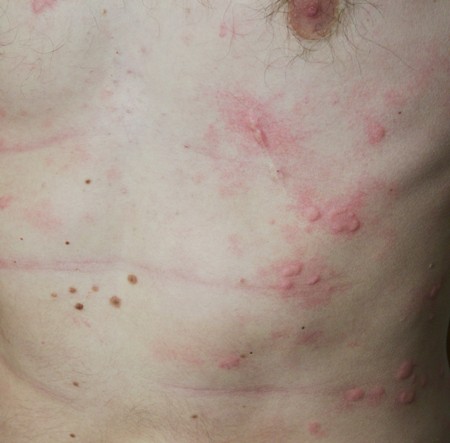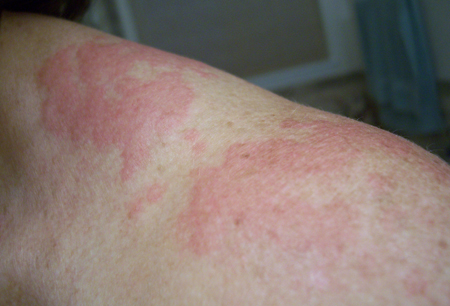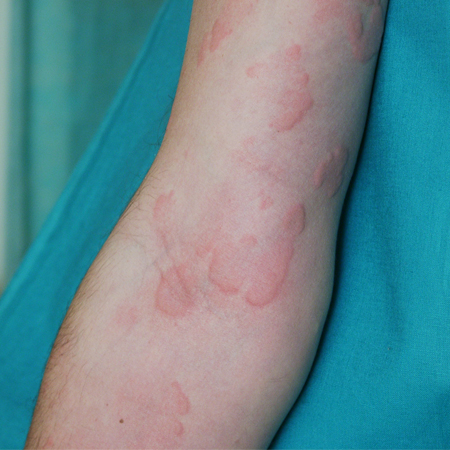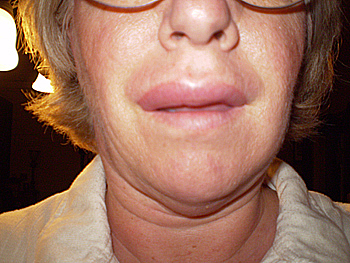Resumo
Differentials
Common
- Acute spontaneous urticaria
- Chronic spontaneous urticaria
- Chronic inducible (physical) urticaria
- Drug eruptions
- Insect bite
- Viral exanthem
- Atopic dermatitis
- Allergic contact dermatitis
- Irritant contact dermatitis
Uncommon
- Erythema multiforme
- Stevens-Johnson syndrome
- Auriculotemporal syndrome
- Bullous pemphigoid
- Cutaneous mastocytosis
- Systemic mastocytosis
- Mast cell activation syndrome
- Urticarial vasculitis
- Transfusion reactions
- Serum sickness
- Cold-induced urticaria, Muckle-Wells syndrome, neonatal multisystem inflammatory disease
- Anaphylaxis
Contributors
Authors
Marilyn Li, MD
Associate Professor of Clinical Pediatrics, Clinician Educator
Director, Quality Improvement and Educational Activities For The Breathmobile Program
Keck School of Medicine, USC
Los Angeles
CA
Disclosures
ML is an unpaid board member of the California Society of Allergy Asthma and Immunology (CSAAI). ML has created CME content on asthma, anaphylaxis, and immunotherapy.
Kenny Y.C. Kwong, MD
Clinical Associate Professor of Pediatrics
Division of Allergy-Immunology
Los Angeles General Medical Center
Los Angeles
CA
Disclosures
KYCK is a consultant and independent contractor for Thermo-Fisher Scientific Immunodiagnostics Division (Phadia).
Acknowledgements
Dr Marilyn Li and Dr Kenny Y.C. Kwong would like to gratefully acknowledge Dr Nanette Silverberg, and Dr Mary Lee-Wong, previous contributors to this topic.
Disclosures
NS and MLW declare that they have no competing interests.
Peer reviewers
Christopher Parrish, MD
Assistant Professor
Pediatrics and Internal Medicine
Division of Allergy and Immunology
UT Southwestern
TX
Disclosures
CP declares that he has no competing interests.
Amor Kachamoune, MD
Assistant Professor
New York University School of Medicine
New York
NY
Disclosures
AK declares that he has no competing interests.
Bettina Wedi, MD
Professor
Head of Allergy Division
Department of Dermatology and Allergy
Hannover Medical School
Hannover
Germany
Disclosures
BW declares that she has no competing interests.
Peer reviewer acknowledgements
BMJ Best Practice topics are updated on a rolling basis in line with developments in evidence and guidance. The peer reviewers listed here have reviewed the content at least once during the history of the topic.
Disclosures
Peer reviewer affiliations and disclosures pertain to the time of the review.
References
Key articles
Bernstein JA, Lang DM, Khan DA, et al. The diagnosis and management of acute and chronic urticaria: 2014 update. J Allergy Clin Immunol. 2014 May;133(5):1270-7. Abstract
European Dermatology Forum. The international EAACI/GA²LEN/EuroGuiDerm/APAAACI guideline for the definition, classification, diagnosis, and management of urticaria. Sep 2021 [internet publication].Full text
Sabroe RA, Lawlor F, Grattan CEH, et al. British Association of Dermatologists guidelines for the management of people with chronic urticaria 2021. Br J Dermatol. 2022 Mar;186(3):398-413.Full text Abstract
Moellman JJ, Bernstein JA, Lindsell C, et al. A consensus parameter for the evaluation and management of angioedema in the emergency department. Acad Emerg Med. 2014 Apr;21(4):469-84.Full text Abstract
Reference articles
A full list of sources referenced in this topic is available to users with access to all of BMJ Best Practice.

Patient information
Dermatitis (seborrheic) of the body
More Patient informationLog in or subscribe to access all of BMJ Best Practice
Use of this content is subject to our disclaimer


